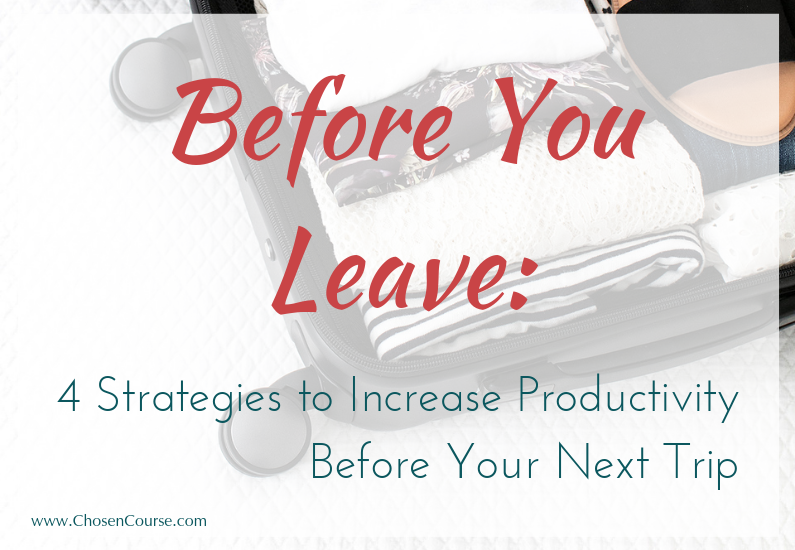As digital nomads and location-independent entrepreneurs, we have the joy of traveling while we work, but that also means that our travel plans have a direct impact on our ability to work.
What happens when the wifi at your new Airbnb goes out or is crap?
What happens when you move to a new location and need a couple days to settle in, find the local libraries, co-working, or good cafes?
What happens when your planes, trains, etc get delayed and time you thought you’d be available to meet with clients or co-workers disappears?
There’s no question that adding travel to your daily life can bring a high volume of “unexpected” incidents into the mix. However, there are also strategies you can use to reduce the impact of these challenges on your personal productivity. Today, I want to share four strategies that can help you both enjoy the freedom of a location-independent lifestyle AND reduce the travel-related challenges on your ability to get stuff done.
Strategy #1: Travel Slower
The Number ONE strategy to reducing the impact of travel on your personal productivity is to SLOW DOWN your travels. Fast travel can be fun, but it can also burn you out. It’s super unsustainable for an extended period of time. When you have to spend time constantly finding new places to work or dealing with wifi troubles in different places every day or week that can massively eat into your productive time.
Basically, every relocation requires a “settling” transition period whether that’s just a day or more, so the best way to improve your productivity while traveling is to reduce these transitions. If you’ve been changing locations every 1-2 weeks, then try slowing down to 1 location per month. If you’ve been staying for a month at a time, then try 2-3 months. We’ve discovered that around 4 months per stay is a good pace for us because it allows us to “live as a local” for a while and really get to know a place (except when we “go home” where we’re aiming for around 5-6 weeks back roughly 2x year.)
You’re the only person who knows what pace works for you, but almost everyone I’ve ever talked to said that slowing down made their traveling lifestyle massively easier and more sustainable over time.
Strategy #2: Do Your Research
Before you even arrive in a new place, do some research. The internet has the answers to many of your common questions.
One key question: where could you work in this new location? Research the local libraries. Use Yelp.com to find the local coffee shops or cafes that you might be able to work from. Join the local expats or similar Facebook groups and ask for recommendations. Getting help from folks who are there or have been there will make your process of finding a functional place much easier.
You can also take a look at this post I wrote a little while ago about creative places to work and make yourself a list of options for “places to work” before you even arrive. Then, you can spend the first few days trying out different ones until you find your sweet spot.
Having this list ready to go allows you to save so much time that you would have spent floundering around in those first few days or week after you arrive in a new place.
Strategy #3: Always Ask for a Speed Test
Before you book your accommodations anywhere, if you’re going to be working at all, then message the host and ask for a speed test. Depending on what kind of work you do, your requirements might vary.
Since both of us rely on a lot of video conferencing we usually aim for 100 mbps down/ 10 mbps up, but that’s simply not possible in some part of the world. Which might mean that you need to postpone that planned trip to India or certain places in South America or Asia until the infrastructure is better. But, many, many location-independent entrepreneurs have no need for frequent video conferencing and can get by with 20/5 service or even less.
Know the threshold of what works for your business’ needs and ask for a speed test in the space. In other words, not just what they’re paying for on their bill, but what they’re actively getting when they’re standing in the living room because they are often not the same thing. My favorite tool is www.Speedtest.net… it’s easy to use even for folks who have no idea how internet speeds work.
Ideally, ask for a screenshot of the speed test, but if that’s not possible, then make sure that you don’t tell potential hosts what number you’re looking for and just ask them to send you the download/upload speeds they get. Then, you can find out how their service measures up. Most people don’t know what a “good number” would be, so not giving them your preferred answer keeps them from fudging or lying to get the booking.
We have also occasionally negotiated with a host where the place fits within our budget/specs if it’s possible to upgrade their service during our stay. We’ve even offered to pay for the difference in price between their current service and the upgraded service. It’s absolutely worth an extra $30-40/month to have higher speeds at home. So, get creative and negotiate when necessary.
Strategy #4: Build a Buffer
Since we know that transitions are some of the hardest times for your personal productivity, always give yourself some grace time.
Build into your schedule a day or two to “settle” in new locations where you’ll stay for a longer period. Don’t schedule client or co-worker calls for the day after you arrive. Just adding this little bit of “buffer” to your plans allows you to ease back into work after travel days, and ensures that if “disasters” strike … like delayed flights, trains, snow storms, hurricanes or just wifi failures at your new home… then you’ll have some time to figure it out before it becomes mission critical.
If everything goes fine and works perfectly, then you’ll have some extra time to clean out your email inbox or plan your next big project while you enjoy getting to know your new cool place. This strategy is rather like the old adage “better to have it and not need it, than to need it and not have it.”
It’s a simply strategy that everyone can use after travel… even our friends and family who are just taking 1-2 week vacations. However, for us travel-lovers who are relocating frequently, it becomes hugely important to reduce stress and make each transition more pleasant.
Next Actions
Did you ever consider that you could create a “process” for your travel planning? In fact, you can even delegate some the work too! We often think about getting help and delegating our work tasks, but we forget that we can get help with our travel-related tasks too. If that sounds like a great idea, then you might want to pick up a copy of:
Your Freedom Map:
A Location-Independent Entrepreneur’s Guide
to End the Grind & Create a Business That Runs on Auto-Pilot.
It will help you:
- Brainstorm the processes that you can simplify, document, and delegate to start freeing your time and energy.
- Learn the difference between a system, a process, and a tool so that you can always be solving the right problem not just churning through new productivity apps.
- Get a step-by-step approach to clarify your business processes so they become easier to do and to delegate.
- Identify the areas of your business where you’ve been “flying-by-the-seat-of-your-pants” for too long and wasting time and energy.
- Discover the 7 Core systems that you NEED to run ALL 50+ Business Processes.



